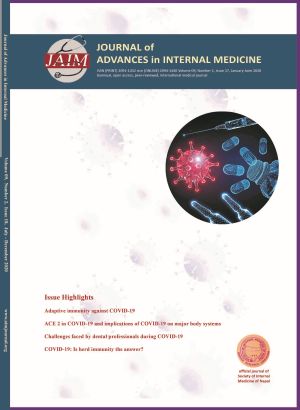Cardiovascular Risk Factors in Pre-dialysis Chronic Kidney Disease patients of Nepal
DOI:
https://doi.org/10.3126/jaim.v9i2.32813Keywords:
CKD, CVD, nontraditional, risk factors, traditionalAbstract
Background and Aims: Cardiovascular disease (CVD) is the commonest cause of morbidity and mortality in patients with chronic kidney disease (CKD) due to increased prevalence of traditional and nontraditional CVD risk factors. Our study aimed to evaluate these risk factors in pre-dialysis Nepalese CKD patients.
Methods: This was a cross-sectional study conducted in Department of Nephrology, Bir hospital. Total 100 consecutive pre-dialysis CKD patients were enrolled. Ten traditional and six nontraditional CVD risk factors were analyzed and compared between CKD stages. Descriptive statistics was used to illustrate the socio-demographic and clinical characteristics, chi square test for categorical variables and multiple logistic regression analysis was done to determine the risk factors of CVD in CKD patients. p-value<0.05 was considered to be statistically significant.
Results: Mean patient age was 52.03}13.64 years with majority (60%) of the patients being male. Comparison of traditional risk factors in different stages depicted similar trend except for old age in Stage 3 CKD (p=0.002). Anemia (p<0.001), hyperphosphatemia (p=0.01), hyperparathyroidism (p<0.01) and cumulative nontraditional risk factors were significantly higher (p=0.01) in stage 5 CKD. The predicted CVD events by Framingham risk score showed high risk in 37% with no significant difference among the stages. Multiple logistic regression analysis showed increased body mass index, low serum albumin and increased serum phosphate as the three significant predictors for left ventricular hypertrophy.
Conclusion: Our study shows that the CVD risk factors were prevailing along the various stages of CKD. The occurrence of non-traditional risk factors increased with increasing stage of CKD.
Downloads
Downloads
Published
How to Cite
Issue
Section
License
This license enables reusers to distribute, remix, adapt, and build upon the material in any medium or format, so long as attribution is given to the creator.




